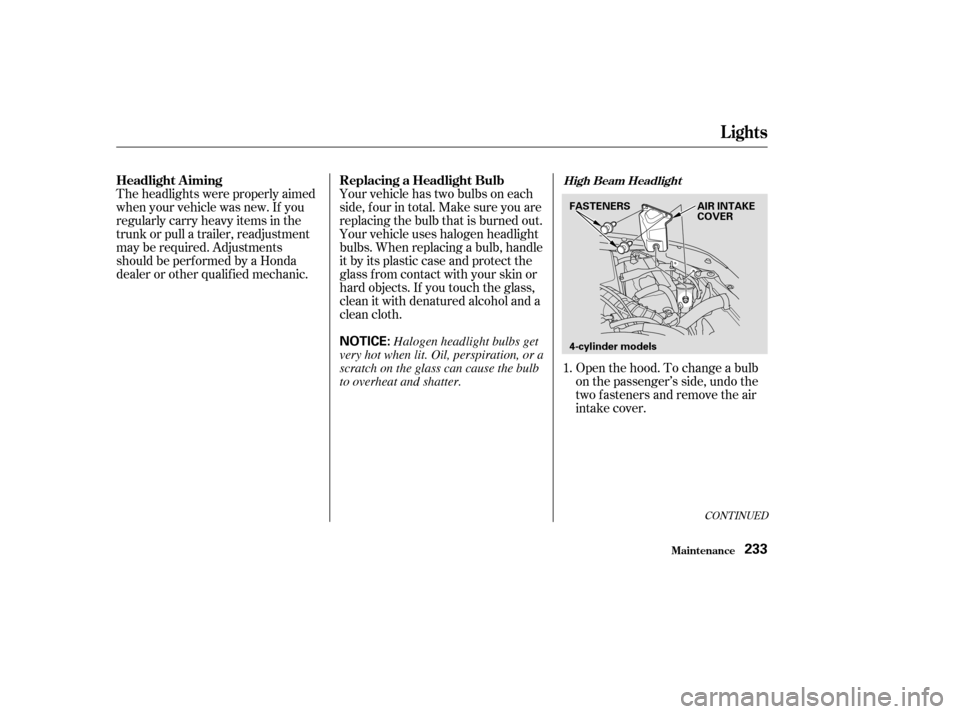Page 154 of 313

The security system helps to protect
your vehicle and valuables f rom thef t.
The horn sounds and a combination
of headlights, parking lights, side
marker lights and taillights f lashes if
someone attempts to break into your
vehicleorremovetheradio.This
alarm continues f or two minutes,
then the system resets. To reset an
alarming system before the two
minutes have elapsed, unlock the
driver’s door with the key or the
remote transmitter.
The security system automatically
sets 15 seconds after you lock the
doors, hood, and trunk. For the
system to activate, you must lock the
doors f rom the outside with the key,
lock tab, door lock switch, or remote
transmitter. The security system
indicator on the instrument panel
starts blinking immediately to show
you the system is setting itself .Once the security system is set,
opening either door without using
the key or the remote transmitter,
the hood, or the trunk will cause it to
sound. It also sounds if the radio is
removed f rom the dashboard or the
wiring is cut.With the system set, you can still
open the trunk with the remote
transmitter without triggering the
alarm. The alarm will sound if the
trunk lock is f orced, or the trunk is
opened with the trunk release handle
or the emergency trunk opener.
The security system will not set if
the hood, trunk, or either door is not
f ully closed. If the system will not set,
check the Door and Trunk Open
Monitor on the instrument panel
(see page ), to see if the doors
and the trunk are f ully closed. Since
it is not part of the monitor display,
manually check the hood.
Do not attempt to alter this system
or add other devices to it.
61
On all models except f or 4-cylinder LX
model and all Canadian models
Comf ort and Convenience Feat ures
Security System
155
SECURITY SYSTEM INDICATOR
�����—�����—�����y�
�������������y���
�(���%���
���y���
�����y
Page 165 of 313

Park the vehicle, and set the
parking brake. Pull the hood
release handle located under the
lower lef t corner of the dashboard.
The hood will pop up slightly.
Screw the f uel f ill cap back on
until it clicks at least three times.
If you do not properly tighten the
cap, the Malf unction Indicator
Lampmaycomeon(seepage
).
Push the f uel f ill door closed until
it latches.
Remove the f uel f ill cap slowly.
You may hear a hissing sound as
pressure inside the tank escapes.
The fuel fill cap is attached to the
f uel f iller with a tether. Put the
attachment on the f uel f ill cap into
the slit on the f uel f ill door.
Stop f illing the tank af ter the f uel
nozzle automatically clicks of f . Do
not try to ‘‘top off’’ the tank. Leave
some room f or the f uel to expand
with temperature changes.
even though the tank is not f ull,
there may be a problem with your
vehicle’s fuel vapor recovery
system. The system helps keep
f uel vapors f rom going into the
atmosphere. Consult your dealer. 5. 6.
1.
3. 4.
269If the f uel nozzle keeps clicking of f
Service Station Procedures
Bef ore Driving
Opening the Hood
166
HOOD RELEASE HANDLE
�����—�����—�����y�
�������������y���
�(���%���
���y���
�����y
Page 166 of 313

Lif t the hood up most of the way.
The hydraulic supports will lif t it
uptherestof thewayandholditup.
Lower the hood to about a f oot (30
cm) above the f ender, then press
down firmly with your hands. Make
sure it is securely latched.
Pull the support rod out of its clip
by holding the grip and insert the
end into the hole on the f ront of
the hood around the center.
Lif t it up slightly to remove the
support rod f rom the hole. Put the
support rod back into its holding
clip. Lower the hood to about a
f oot (30 cm) above the f ender,
then let it drop. Make sure it is
securely latched.
Reach in between the hood and
the f ront grille with your f inger.
The hood latch handle is above
and to the lef t of the ‘‘H’’ logo.
Push this handle up until it
releases the hood. Lif t the hood.
If the hood latch handle moves
stif f ly, or if you can open the hood
without lifting the handle, the
mechanism should be cleaned and
lubricated (see page ).
3.
2.
232
6-cylinder modelsTo Close the Hood:
To Close the Hood:
4-cylinder models
Service Station Procedures
Bef ore Driving167
GRIP
CLIP
4-cylinder models 6-cylinder models
LATCH
�����—�����—�����y�
�������������y���
�(���%���
���y���
�����y
Page 218 of 313
Open the hood and remove the
engine oil f ill cap. Remove the oil
drain bolt and washer f rom the
bottom of the engine. Drain the oil
into an appropriate container.Remove the oil f ilter and let the
remaining oil drain. A special
wrench (available from your
Honda dealer) is required.
Install a new oil f ilter according to
the instructions that come with it.
Make sure to clean of f any dirt
and dust on the connecting
surf ace of a new oil f ilter.
4.
3.
2.
CONT INUED
Changing the Oil and Filter
Maint enance219
4-cylinder models OIL DRAIN BOLT OIL DRAIN BOLT
WASHER
OIL FILTER
4-cylinder models
6-cylinder models WASHER
�����—�����—�����y�
�������������y���
�(���%���
���y���������y
Page 232 of 313

Theheadlightswereproperlyaimed
when your vehicle was new. If you
regularly carry heavy items in the
trunk or pull a trailer, readjustment
may be required. Adjustments
should be perf ormed by a Honda
dealer or other qualif ied mechanic.Your vehicle has two bulbs on each
side, f our in total. Make sure you are
replacing the bulb that is burned out.
Your vehicle uses halogen headlight
bulbs. When replacing a bulb, handle
it by its plastic case and protect the
glass from contact with your skin or
hard objects. If you touch the glass,
clean it with denatured alcohol and a
clean cloth.
Open the hood. To change a bulb
on the passenger’s side, undo the
two fasteners and remove the air
intake cover.
1.
CONT INUED
Lights
Headlight A iming Replacing a Headlight BulbHigh Beam Headlight
Maint enance233
NOTICE:4-cylinder models
FASTENERS AIR INTAKE
COVERHalogen headlight bulbs get
very hot when lit. Oil, perspiration, or a
scratch on the glass can cause the bulb
to overheat and shatter.
�����—�����—�����y�
�����������
�y���
�(���%���
���y���������y
Page 242 of 313
Check the condition of the wiper
blades at least every six months.
Replace them if you f ind signs of
cracking in the rubber, and areas
that are getting hard, or if they leave
streaks and unwiped areas when
used.To replace a wiper blade:Raise the wiper arm of f the
windshield. Raise the driver’s side
first, then the passenger’s side. Disconnect the blade assembly
fromthewiperarmbypushingin
the lock tab. Hold the lock tab in
while you push the blade assembly
toward the base of the arm.
2.
1.
CONT INUED
Wiper Blades
Maint enance243
NOTICE:
WIPER ARMS
LOCK TAB
Do not open the hood when
the wiper arms are raised, or you will
damage the hood and the wiper arms.
�����—�����—�����y�
�������������y���
�(���%���
���y���������y
Page 263 of 313

�µ
�´ �´
Although this seems like a simple
procedure, you should take several
precautions.
You cannot start a Honda with an
automatic transmission by pushing
or pulling it.
Connect the second jumper cable
to the negative ( ) terminal on
the booster battery. Connect the
other end to the grounding strap
as shown. Do not connect this
jumper cable to any other part of
the engine.
Open the hood and check the
physical condition of the battery.
In very cold weather, check the
condition of the electrolyte. If it
seems slushy or like ice, do not try
jump starting until it thaws.
Turn of f all the electrical acces-
sories: heater, A/C, climate
control, stereo system, lights, etc.
Put the transmission in Neutral or
Park, and set the parking brake.
Connect one jumper cable to the
positive ( ) terminal on your
Honda’s battery. Connect the
other end to the positive ( )
terminal on the booster battery.
1. 2.
4.
3.
Jump Starting
T aking Care of t he Unexpect ed
To Jump Start Your Vehicle:
264
NOTICE:
4-cylinder models
A battery can explode if you do
not follow the correct procedure,
seriously injuring anyonenearby.
Keep all sparks, open flames,
and smoking materials away
from the battery. If a battery sits in extreme
cold, the electrolyte inside can f reeze.
Attempting to jump start with a f rozen
battery can cause it to rupture.
�����—�����—�����y�
�������������y���
�(���%���
���y���������y
Page 265 of 313

The pointer of your vehicle’s
temperature gauge should stay in
the midrange. If it climbs to the red
mark, you should determine the
reason (hot day, driving up a steep
hill, etc.).
If your vehicle overheats, you should
take immediate action. The only
indication may be the temperature
gauge climbing to or above the red
mark. Or you may see steam or
spray coming f rom under the hood.Saf ely pull to the side of the road.
Put the transmission in Neutral or
Park, and set the parking brake.
Turn of f all accessories, and turn
on the hazard warning indicators.
If you see steam and/or spray
coming f rom under the hood, turn
of f the engine. Wait until you see
no more signs of steam or spray,
then open the hood.If you do not see steam or spray,
leave the engine running and
watch the temperature gauge. If
the high heat is due to overloading,
the engine should start to cool
down almost immediately. If it
does, wait until the temperature
gauge comes down to the midpoint,
then continue driving.
If the temperature gauge stays at
the red mark, turn of f the engine.
Look f or any obvious coolant leaks,
such as a split radiator hose.
Everything is still extremely hot,
so use caution. If you f ind a leak, it
must be repaired bef ore you
continue driving (see
on page ).
2.
1. 3. 4. 5.
272
If theEngineOverheats
T aking Care of t he Unexpect ed
Emergency
Towing
266
NOTICE: Steam and spray from an
overheated engine can
seriously scald you.
Do not open the hood if steam
is coming out.
Driving with the temperature
gauge pointer at the red mark can
cause serious damage to your engine.
�����—�����—�����y�
�������������y���
�(���%���
���y���������y